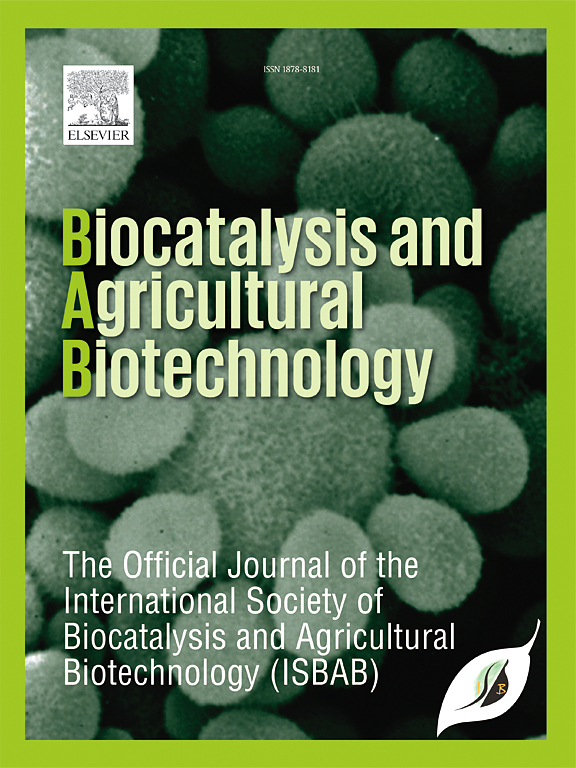Unlocking the industrial potential of Withania somnifera (L.) Dunal: A varietal comparison of morphology, microstructure, and metabolomic profiles
IF 3.4
Q2 BIOTECHNOLOGY & APPLIED MICROBIOLOGY
引用次数: 0
Abstract
To address the lack of publications on the metabolic profiling of W. somnifera varieties for industrial and pharmaceutical uses, we conducted a comprehensive analysis of the phytochemistry in three ashwagandha varieties- Red (R), Wild (W), and Pratap (P)- with a focus on their distinctive traits and potential commercial applications. Our research involved studies on germination, morphological assessments, and tissue culture experiments to understand growth potential and physical traits. Additionally, microscopic examinations of leaf structures and advanced techniques such as Raman spectroscopy and high-resolution mass spectrometry were used to analyse their biochemical and metabolite profiles. R exhibited a 101.5 % increase in total biomass in the field, while W showed the most vigorous in-vitro growth. The P variety had a high density of glandular trichomes, crucial for secondary metabolite production. Raman analysis revealed Withaferin A was most abundant in R, and phenylalanine was highest in P. HRMS results indicated comparable levels of terpenes in W and P, with P having higher fatty acids and steroids, known for skincare benefits. Peptides and amines were similarly high in R and W, supporting their therapeutic uses. These comprehensive plans revealed notable differences in the chemical profiles of the three varieties, emphasizing their potential for various industrial applications. This study not only adds to the understanding of the phytochemical diversity within W. somnifera but also further enables the improvement of the efficiency of cultivation and processing techniques for better medicinal and commercial outcomes.

挖掘睡茄(Withania somnifera (L.) Dunal)的工业潜力:形态、微观结构和代谢组学特征的品种比较
为了解决缺乏对用于工业和医药用途的冬凌草品种进行新陈代谢分析的问题,我们对红(Red)、野(Wild)和普拉塔普(Pratap)这三个灰树叶品种的植物化学进行了全面分析,重点是它们的独特性状和潜在的商业应用。我们的研究包括发芽研究、形态评估和组织培养实验,以了解生长潜力和物理特性。此外,我们还利用叶片结构显微镜检查以及拉曼光谱和高分辨率质谱等先进技术来分析它们的生化和代谢特征。R 品种的田间总生物量增加了 101.5%,而 W 品种的体外生长最为旺盛。P 品种的腺毛密度很高,这对次生代谢物的产生至关重要。拉曼分析表明,R 中的 Withaferin A 含量最高,而 P 中的苯丙氨酸含量最高。HRMS 结果表明,W 和 P 中的萜烯含量相当,而 P 中的脂肪酸和类固醇含量更高,这两种物质具有护肤功效。肽和胺在 R 和 W 中的含量同样很高,支持了它们的治疗用途。这些综合计划揭示了这三个品种化学特征的显著差异,强调了它们在各种工业应用中的潜力。这项研究不仅加深了人们对索姆尼费拉植物化学多样性的了解,还进一步提高了栽培和加工技术的效率,以获得更好的药用和商业效果。
本文章由计算机程序翻译,如有差异,请以英文原文为准。
求助全文
约1分钟内获得全文
求助全文
来源期刊

Biocatalysis and agricultural biotechnology
Agricultural and Biological Sciences-Agronomy and Crop Science
CiteScore
7.70
自引率
2.50%
发文量
308
审稿时长
48 days
期刊介绍:
Biocatalysis and Agricultural Biotechnology is the official journal of the International Society of Biocatalysis and Agricultural Biotechnology (ISBAB). The journal publishes high quality articles especially in the science and technology of biocatalysis, bioprocesses, agricultural biotechnology, biomedical biotechnology, and, if appropriate, from other related areas of biotechnology. The journal will publish peer-reviewed basic and applied research papers, authoritative reviews, and feature articles. The scope of the journal encompasses the research, industrial, and commercial aspects of biotechnology, including the areas of: biocatalysis; bioprocesses; food and agriculture; genetic engineering; molecular biology; healthcare and pharmaceuticals; biofuels; genomics; nanotechnology; environment and biodiversity; and bioremediation.
 求助内容:
求助内容: 应助结果提醒方式:
应助结果提醒方式:


